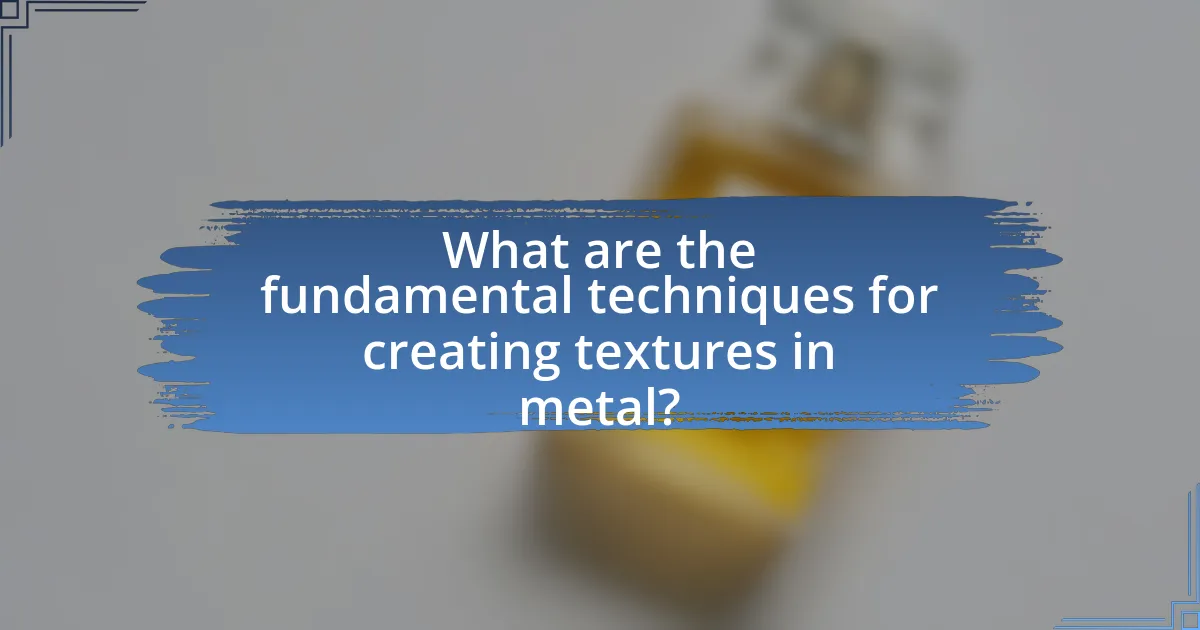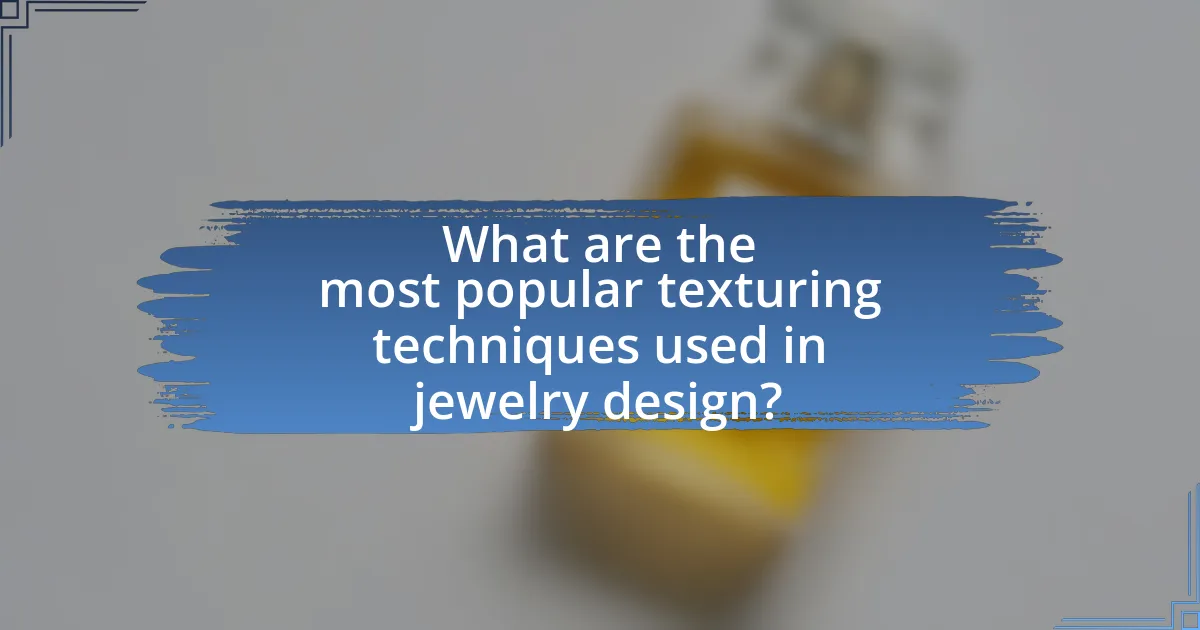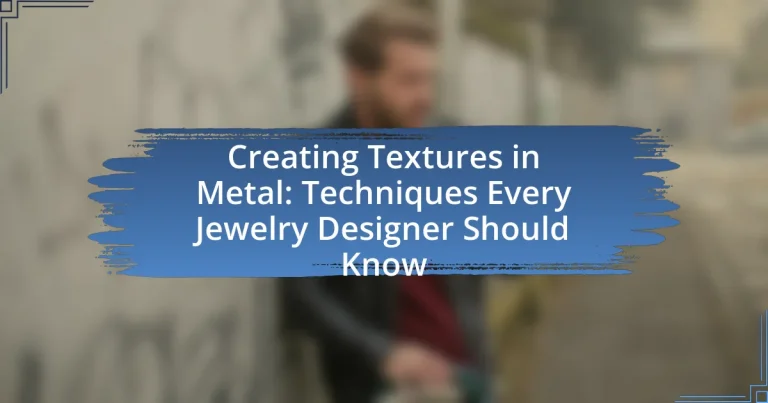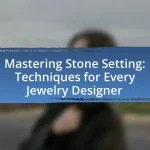The article focuses on the essential techniques for creating textures in metal, particularly in jewelry design. It covers fundamental methods such as hammering, etching, and rolling, explaining how each technique contributes to the aesthetic appeal of metal pieces. The article also discusses the visual and tactile benefits of textured metal, the tools required for texturing, and the influence of different metals on texturing outcomes. Additionally, it addresses safety considerations, innovative approaches to layering textures, and common challenges faced by designers, providing a comprehensive guide for jewelry artisans looking to enhance their craft through effective texturing techniques.

What are the fundamental techniques for creating textures in metal?
The fundamental techniques for creating textures in metal include hammering, etching, and rolling. Hammering involves striking the metal surface with a tool to create patterns and indentations, which can produce a variety of textures depending on the hammer type and technique used. Etching utilizes acid or other chemicals to remove material from the metal surface, allowing for intricate designs and textures to be formed. Rolling, often done with a rolling mill, compresses the metal between two rollers, which can imprint textures from patterned rollers or create a smooth finish. These techniques are widely used in jewelry design to enhance the aesthetic appeal of metal pieces.
How do different textures enhance jewelry design?
Different textures enhance jewelry design by adding depth, visual interest, and tactile appeal to pieces. Textures can create contrasts that highlight specific design elements, making them more prominent and engaging. For instance, a polished surface juxtaposed with a matte finish can draw attention to the intricacies of a design, while hammered textures can evoke a sense of organic beauty and craftsmanship. Additionally, textured surfaces can reflect light in varied ways, contributing to the overall aesthetic and allure of the jewelry. This interplay of light and shadow not only enhances the visual complexity but also invites touch, making the piece more interactive and memorable for the wearer.
What are the visual and tactile benefits of textured metal?
Textured metal offers distinct visual and tactile benefits that enhance its aesthetic appeal and usability. Visually, textured metal creates depth and interest through patterns and finishes, which can catch and reflect light in unique ways, making pieces more dynamic and engaging. Tactile benefits include an enhanced sensory experience; the varied surfaces invite touch, providing a more interactive and appealing feel compared to smooth metal. This combination of visual intrigue and tactile engagement can elevate the overall design of jewelry, making it more attractive to consumers.
How do textures influence the overall aesthetic of a piece?
Textures significantly influence the overall aesthetic of a piece by adding depth, visual interest, and tactile qualities. In jewelry design, varied textures can evoke different emotions and perceptions; for instance, a polished surface may convey elegance, while a rough texture can suggest rustic charm. Research indicates that texture affects viewer engagement, as studies show that textured surfaces are more likely to attract attention and elicit a sensory response. This is supported by findings from the Journal of Experimental Psychology, which highlight that tactile experiences can enhance the perceived value of an object. Therefore, the strategic use of textures in metal jewelry not only enhances its beauty but also enriches the viewer’s experience.
What tools are essential for texturing metal?
Essential tools for texturing metal include hammers, texture plates, and rotary tools. Hammers, such as chasing and planishing hammers, create various surface patterns through impact. Texture plates, often made of steel or brass, allow for the imprinting of designs onto metal surfaces. Rotary tools, equipped with different attachments, enable intricate detailing and finishing touches. These tools are fundamental in jewelry design, as they facilitate the creation of unique textures that enhance the aesthetic appeal of metal pieces.
Which hand tools are commonly used for metal texturing?
Commonly used hand tools for metal texturing include hammers, files, and texture plates. Hammers, such as chasing hammers and ball peen hammers, are utilized to create various surface patterns and textures through impact. Files are employed to refine edges and add intricate details, while texture plates allow for the imprinting of designs onto metal surfaces. These tools are essential in jewelry design, enabling artisans to manipulate metal surfaces effectively and achieve desired aesthetic effects.
What role do power tools play in creating textures?
Power tools are essential in creating textures in metal by enabling precise and efficient manipulation of surfaces. These tools, such as rotary tools, grinders, and sanders, allow jewelry designers to achieve a variety of textures, from smooth finishes to intricate patterns. For instance, a rotary tool can be fitted with different attachments to create unique designs, while grinders can remove material quickly to form desired textures. The use of power tools not only enhances the speed of the texturing process but also improves the consistency and quality of the textures produced, making them a vital component in modern jewelry design.
What materials are best suited for texturing techniques?
Metals such as copper, brass, and silver are best suited for texturing techniques in jewelry design. These materials possess malleability and ductility, allowing them to be easily manipulated through various texturing methods like hammering, etching, and rolling. Copper, for instance, is widely used due to its excellent workability and ability to hold textures well, while brass offers a similar quality with added durability. Silver, known for its luster and aesthetic appeal, also responds effectively to texturing techniques, making it a popular choice among jewelry designers.
How does the choice of metal affect texturing outcomes?
The choice of metal significantly influences texturing outcomes due to variations in malleability, hardness, and surface characteristics. For instance, softer metals like copper and silver allow for more intricate textures and patterns to be created easily, as they can be manipulated without cracking. In contrast, harder metals such as titanium and stainless steel require more force and specialized tools to achieve similar texturing effects, often resulting in less detailed designs. Additionally, the surface finish of different metals affects how textures appear; polished surfaces reflect light differently than matte finishes, altering the visual impact of the texture. Therefore, selecting the appropriate metal is crucial for achieving desired texturing results in jewelry design.
What are the properties of different metals that influence texturing?
The properties of different metals that influence texturing include malleability, ductility, hardness, and surface finish. Malleability allows metals like gold and silver to be easily shaped and textured without breaking, making them ideal for intricate designs. Ductility, particularly in metals such as copper, enables them to be drawn into thin wires or sheets, facilitating various texturing techniques. Hardness affects how well a metal can retain a texture; harder metals like titanium may require specialized tools for texturing, while softer metals can be more easily manipulated. Surface finish, which varies by metal, impacts the final appearance of the texture; for instance, polished surfaces reflect light differently than matte finishes, influencing the visual outcome of the texturing process.
How can jewelry designers combine textures with other design elements?
Jewelry designers can combine textures with other design elements by layering different surface finishes, such as matte, polished, and hammered, to create visual contrast and depth. This technique enhances the overall aesthetic by allowing the textures to interact with light differently, thereby drawing attention to specific areas of the piece. For instance, a polished gemstone can be set against a textured metal background, highlighting both the stone’s brilliance and the intricacy of the metalwork. Additionally, designers can incorporate color through enamel or gemstones, which can further accentuate the textures, creating a harmonious balance between tactile and visual elements. This approach is supported by the fact that contrasting textures can evoke emotional responses and enhance the wearer’s experience, as seen in various successful jewelry collections.
What are the safety considerations when texturing metal?
When texturing metal, safety considerations include the use of personal protective equipment (PPE) such as gloves, goggles, and masks to prevent injury from sharp edges, flying debris, and harmful dust. Additionally, ensuring proper ventilation is crucial to avoid inhalation of toxic fumes generated during processes like soldering or chemical treatments. The handling of tools and machinery requires adherence to safety protocols to minimize the risk of accidents, such as cuts or burns. Furthermore, awareness of the specific properties of the metal being textured, including its reactivity and potential hazards, is essential for safe handling.

What are the most popular texturing techniques used in jewelry design?
The most popular texturing techniques used in jewelry design include hammering, reticulation, and sandblasting. Hammering creates unique patterns and textures by striking the metal with a hammer, resulting in a visually dynamic surface. Reticulation involves heating the metal to create a surface that appears wrinkled or rippled, adding depth and interest. Sandblasting uses abrasive materials to create a matte finish, enhancing the visual appeal of the piece. These techniques are widely utilized by jewelry designers to add character and uniqueness to their creations.
How does hammering create unique textures in metal?
Hammering creates unique textures in metal by altering its surface through mechanical deformation. The process involves striking the metal with a hammer, which compresses and stretches the material, resulting in varied surface patterns and finishes. This technique can produce effects such as dimples, ridges, and waves, depending on the hammer’s shape and the force applied. The unique textures arise from the way the metal’s crystalline structure is rearranged during hammering, leading to distinct visual and tactile qualities.
What types of hammers are best for texturing?
The best types of hammers for texturing in metalwork are texturing hammers, planishing hammers, and chasing hammers. Texturing hammers feature various patterned faces that create unique surface designs on metal, making them ideal for adding decorative textures. Planishing hammers are used to smooth and refine surfaces while also imparting a subtle texture, which is essential for achieving a polished finish. Chasing hammers, with their flat faces, are effective for creating detailed designs and textures through controlled strikes. These hammers are widely recognized in jewelry design for their ability to manipulate metal surfaces effectively, enhancing both aesthetic appeal and craftsmanship.
How can hammering be used to create patterns?
Hammering can be used to create patterns by applying force to metal surfaces, resulting in indentations and textures that enhance visual appeal. This technique allows jewelry designers to manipulate the metal’s surface, creating unique designs through various hammer shapes and striking methods. For instance, using a textured hammer can imprint specific patterns, while varying the angle and pressure can produce different effects. Historical practices in metalworking demonstrate that hammering has been utilized for centuries to achieve decorative finishes, confirming its effectiveness in pattern creation.
What is the process of etching and how is it applied to metal?
Etching is a process that involves using acid or other chemicals to remove material from the surface of metal, creating designs or textures. In metal etching, a protective coating is first applied to the metal surface, which is then exposed to a design through a resist method, such as photoresist or vinyl. After the design is created, the metal is submerged in an acid solution that reacts with the exposed areas, effectively etching the design into the metal. This technique is widely used in jewelry design to create intricate patterns and textures, enhancing the aesthetic appeal of the pieces. Historical evidence shows that etching has been utilized since the 15th century, particularly in printmaking and metalwork, demonstrating its long-standing significance in artistic applications.
What materials are needed for etching metal?
To etch metal, the essential materials required include a metal substrate, an etching resist, an etching solution, and protective gear. The metal substrate serves as the base for the etching process, while the etching resist, such as a vinyl or wax, protects areas of the metal from being etched. The etching solution, often composed of ferric chloride or nitric acid, is used to remove the exposed metal. Protective gear, including gloves and goggles, is necessary to ensure safety while handling chemicals. These materials are fundamental for achieving precise and effective metal etching in jewelry design.
How does etching differ from other texturing methods?
Etching differs from other texturing methods by utilizing a chemical process to remove material from a metal surface, creating intricate designs. Unlike techniques such as hammering or stamping, which physically deform the metal, etching involves applying an acid or abrasive solution to selectively dissolve areas of the metal. This method allows for greater precision and detail, enabling the creation of complex patterns that are difficult to achieve through mechanical means. For instance, etching can produce fine lines and delicate textures that enhance the visual appeal of jewelry pieces, making it a preferred choice for detailed designs.
How can stamping be utilized to create textures?
Stamping can be utilized to create textures by applying pressure to a metal surface with a patterned die, resulting in a permanent impression. This technique allows jewelry designers to achieve intricate designs and textures that enhance the visual appeal of their pieces. For instance, using a textured stamp can create patterns such as leaves, flowers, or geometric shapes, which can be further enhanced by techniques like patination or polishing. The effectiveness of stamping in texture creation is evidenced by its widespread use in metalworking, where it is recognized for producing consistent and repeatable designs efficiently.
What types of stamps are available for jewelry designers?
Jewelry designers have access to various types of stamps, including metal stamps, texture stamps, and letter stamps. Metal stamps are used for imprinting designs or patterns onto metal surfaces, while texture stamps create unique surface textures. Letter stamps allow designers to engrave letters or numbers for personalization. These stamps are essential tools for adding detail and individuality to jewelry pieces, enhancing their aesthetic appeal and marketability.
How can stamping be combined with other techniques for enhanced effects?
Stamping can be combined with techniques such as etching, enameling, and patination to create enhanced effects in metalwork. For instance, when stamping is used alongside etching, the stamped design can be further defined by the etched lines, adding depth and detail. Enameling can introduce vibrant colors to the stamped patterns, allowing for a striking contrast between the metal and the enamel. Additionally, patination can alter the surface finish of stamped pieces, creating unique color variations and textures that enhance the overall aesthetic. These combinations not only elevate the visual appeal but also expand the creative possibilities for jewelry designers.
What are the benefits of using chemical treatments for texturing?
Chemical treatments for texturing provide enhanced surface finishes, increased durability, and the ability to achieve intricate designs that are difficult to replicate through mechanical methods. These treatments, such as acid etching or anodizing, allow for precise control over texture depth and pattern, resulting in unique visual effects that can elevate the aesthetic appeal of metal jewelry. For instance, acid etching can create fine details and complex patterns that enhance the overall design, while anodizing can introduce vibrant colors and improve corrosion resistance.
How do chemical treatments alter the surface of metal?
Chemical treatments alter the surface of metal by inducing changes in its chemical composition and physical properties. These treatments, such as etching, anodizing, and passivation, can create textures, enhance corrosion resistance, and improve adhesion for coatings. For instance, etching involves using acids to selectively remove material, resulting in intricate designs and textures on the metal surface. Anodizing, commonly applied to aluminum, forms a protective oxide layer that increases durability and allows for dyeing, thus enhancing aesthetic appeal. Passivation, often used on stainless steel, enhances corrosion resistance by forming a protective oxide layer that prevents rust. These processes are essential in jewelry design, as they not only improve the functionality of the metal but also contribute to its visual characteristics.
What safety precautions should be taken when using chemicals?
When using chemicals, it is essential to wear appropriate personal protective equipment (PPE) such as gloves, goggles, and masks to prevent skin and eye contact, as well as inhalation of harmful fumes. Additionally, working in a well-ventilated area or using fume hoods minimizes exposure to toxic vapors. Proper storage of chemicals in labeled containers reduces the risk of accidental spills or reactions. Following Material Safety Data Sheets (MSDS) for each chemical provides specific handling and emergency procedures, ensuring safe usage. These precautions are critical as exposure to hazardous chemicals can lead to serious health issues, including respiratory problems and skin irritation.

How can jewelry designers innovate with textures in their work?
Jewelry designers can innovate with textures by employing techniques such as etching, hammering, and using mixed materials. These methods allow for the creation of unique surface patterns and tactile experiences that enhance the visual appeal of the jewelry. For instance, etching can produce intricate designs on metal surfaces, while hammering creates a dynamic interplay of light and shadow. Additionally, incorporating materials like wood or resin alongside metal can introduce contrasting textures, further enriching the design. This approach not only differentiates a designer’s work but also aligns with contemporary trends that favor individuality and craftsmanship in jewelry design.
What are some creative ways to layer textures in jewelry design?
Layering textures in jewelry design can be achieved through techniques such as combining different metal finishes, utilizing contrasting materials, and employing various texturing methods. For instance, a designer can create a visually striking piece by pairing a polished metal surface with a matte or sandblasted finish, enhancing depth and interest. Additionally, incorporating materials like leather or fabric alongside metal can introduce unique tactile contrasts. Techniques such as etching, hammering, or using a rolling mill to imprint patterns can further diversify the textures, allowing for intricate designs that capture light and attention. These methods are widely recognized in the jewelry industry for their effectiveness in creating dynamic and engaging pieces.
How can contrasting textures enhance a piece’s visual appeal?
Contrasting textures enhance a piece’s visual appeal by creating depth and interest, drawing the viewer’s eye to different areas of the design. For instance, combining a polished surface with a matte finish can highlight specific features, making them stand out. This technique is supported by design principles that suggest varied textures can evoke emotional responses and enhance the overall aesthetic experience. In jewelry design, the juxtaposition of smooth and rough textures can also reflect light differently, adding dynamic visual effects that engage the observer.
What techniques can be used to achieve a mixed-media effect?
Techniques to achieve a mixed-media effect include layering different materials, combining painting with collage, and integrating textiles with metal. Layering allows artists to create depth by stacking various elements, such as paper, fabric, and paint, which can enhance visual interest. Combining painting with collage involves applying paint over cut-out images or textures, creating a dynamic interplay between the two mediums. Integrating textiles with metal, often seen in jewelry design, adds tactile qualities and contrasts, enriching the overall aesthetic. These techniques are widely used in contemporary art and design, demonstrating their effectiveness in creating unique mixed-media compositions.
How can textures be used to tell a story in jewelry design?
Textures in jewelry design can convey emotions, themes, and narratives by evoking sensory experiences and cultural associations. For instance, a rough, unpolished texture may symbolize natural beauty or resilience, while a smooth, polished surface can represent elegance and sophistication. Historical context supports this, as ancient civilizations often used texture to signify status or tell stories through their adornments, such as the intricate carvings found in Egyptian jewelry that depicted deities and myths. Thus, the choice of texture not only enhances the aesthetic appeal but also deepens the narrative significance of the piece.
What themes can be expressed through textural choices?
Textural choices in jewelry design can express themes such as nature, emotion, and cultural identity. For instance, organic textures can evoke themes of nature and the environment, reflecting elements like leaves or water. Conversely, smooth and polished surfaces may convey themes of elegance and sophistication, often associated with modern aesthetics. Additionally, intricate patterns can represent cultural heritage, showcasing traditional craftsmanship and storytelling. These associations are supported by the fact that texture influences the viewer’s emotional response and interpretation of the piece, as demonstrated in various art and design studies.
How can personal experiences influence textural design decisions?
Personal experiences significantly influence textural design decisions by shaping an individual’s aesthetic preferences and emotional responses to materials. Designers often draw from their own life experiences, such as cultural background, personal memories, and emotional connections, which inform their choices in texture, pattern, and form. For instance, a designer who has a background in nature may incorporate organic textures that evoke feelings of tranquility and connection to the environment. This is supported by studies indicating that personal narratives and memories can enhance creativity and innovation in design, as seen in the work of designers who utilize their unique life stories to create distinctive textures that resonate with their audience.
What are some common challenges faced when creating textures in metal?
Common challenges faced when creating textures in metal include achieving uniformity, controlling the depth of texture, and managing the effects of heat treatment. Uniformity is difficult because variations in metal properties can lead to inconsistent textures across a piece. Controlling the depth of texture is challenging as different techniques, such as hammering or etching, can produce varying results that may not meet design specifications. Additionally, heat treatment can alter the texture, potentially leading to unintended changes in appearance or structural integrity. These challenges require careful planning and execution to ensure the desired outcome in metal texture creation.
How can designers troubleshoot issues with texture application?
Designers can troubleshoot issues with texture application by systematically assessing the tools, materials, and techniques used during the process. First, they should evaluate the texture tools for wear or damage, as worn tools can lead to inconsistent texture results. Next, they must examine the metal surface preparation; inadequate cleaning or polishing can prevent proper texture adhesion. Additionally, designers should consider the application technique, ensuring that pressure and angle are appropriate for the desired effect. Finally, testing on scrap metal before applying textures to final pieces can help identify potential issues early. This methodical approach allows designers to pinpoint and resolve texture application problems effectively.
What are the best practices for achieving consistent results?
The best practices for achieving consistent results in creating textures in metal involve meticulous preparation, controlled techniques, and regular practice. Jewelry designers should start with high-quality materials and tools, ensuring that their workspace is organized and free from distractions. Consistency in technique, such as maintaining uniform pressure and speed during texturing processes, is crucial. Additionally, documenting each step of the process allows for replication of successful outcomes. Research indicates that artists who engage in deliberate practice, focusing on specific skills over time, achieve higher levels of consistency in their work.
What tips can help jewelry designers master texturing techniques?
Jewelry designers can master texturing techniques by practicing various methods such as hammering, etching, and using texture plates. Hammering creates unique patterns and can be done with different types of hammers to achieve diverse effects. Etching involves applying a resist to metal and using acid to create intricate designs, allowing for precision and detail. Texture plates, which are engraved with patterns, can be used to imprint textures onto metal surfaces, providing consistency and repeatability in designs. These techniques are validated by their widespread use in the industry, as they enhance the aesthetic appeal and tactile quality of jewelry pieces.


